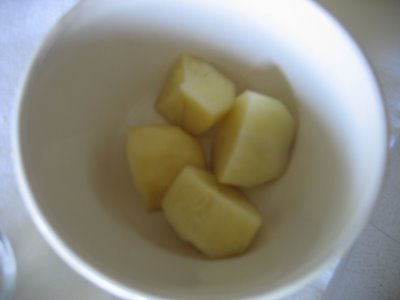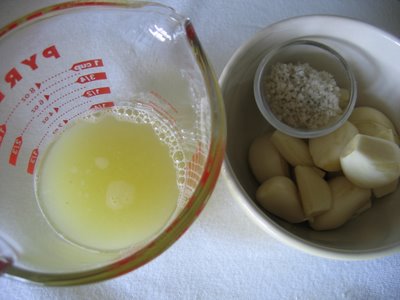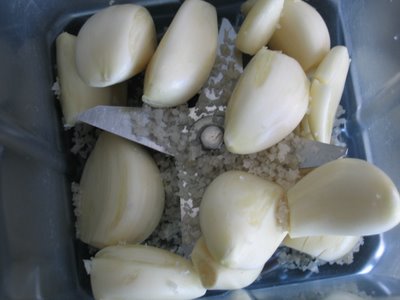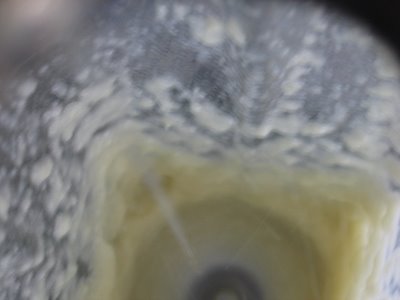thoum — aïoli's lebanese cousin
i have now posted version II for this recipe. the following is more on the traditional side (eggless). read both posts to decide which you want/like!

[this would have come in helpful for fighting vampires last night ....]

[this would have come in helpful for fighting vampires last night ....]
thoum is the unctuous concoction of only a few basic ingredients which are pounded together, or in this case blended, to form a zesty sauce used as a condiment for meats, fish, vegetables or dipping in pita, fries or better yet — coating crispy, oven roasted potato wedges.
many mediterranean cultures have variations of this punchy garlic sauce. different versions include the provençal aïoli, the greek scordalia, and the catalonian allioli. there are also subvariations such as the french aillade.
to make this recipe you must have your mise-en-place ready. it can sometimes be a fussy sauce because of the oil & acid amalgamation. it is not the sort of thing you stop to go and ream your lemon and then measure oil.
in terms of preparation techniques, traditionally the thoum is made in a wooden mortar but it can be made the easier and faster way, in a blender or food processor, with the blender being a better choice. the sauce can be made with just garlic, lemon juice, salt and oil but this is an unstable mixture requiring skill at combining the oil with the garlic — a sometimes difficult procedure, especially for beginners. because of this, people will add a thickener like potato, mayonnaise or soaked bread which has been squeezed dry to bind it. i am showing you the easier way here today and will post the other method some time in the future. i suggest reading the whole recipe first before starting to decide how you want to proceed with it.
updated version *II* .
thoum
ingredients:

1 head of garlic, separated & peeled
1/8 c lemon juice [up to 1/4 c]
1/2 - 1 tsp kosher salt, not regular small grained
1/4 - 1/2 tsp sugar
1/4 c mild olive oil
1/4 c vegetable oil
thickening agents:
1 very small floury potato OR
mayonnaise (LOTS) OR
bread soaked & squeezed dry
method:
choose a small floury potato [not waxy, this is important], peel it and either microwave it or cook it in a small pot of boiling water. you may cut it in 4 pieces to cook faster. let it cool and set aside for use later.
 separate all the cloves of the garlic, peel and place aside. measure out your salt, lemon juice and oil. put the oil in a pyrex type vessel that you can pour from.
separate all the cloves of the garlic, peel and place aside. measure out your salt, lemon juice and oil. put the oil in a pyrex type vessel that you can pour from.

 in a blender, add the salt and garlic and process until very well ground. add your lemon juice. start with 1/8 c to begin with [if you would like it more sour, add another tablespoon or two at this point]. i add 1/4 - 1/2 tsp sugar to balance the lemon.
in a blender, add the salt and garlic and process until very well ground. add your lemon juice. start with 1/8 c to begin with [if you would like it more sour, add another tablespoon or two at this point]. i add 1/4 - 1/2 tsp sugar to balance the lemon.
 with the motor running on low, start to very slowly add the oil in a steady stream.
with the motor running on low, start to very slowly add the oil in a steady stream.
 after about 1/4 c has been added, turn up the speed and continue adding the rest until all has been added. blend for about 20 seconds at high speed.
after about 1/4 c has been added, turn up the speed and continue adding the rest until all has been added. blend for about 20 seconds at high speed.

at this point, the thoum is ready to use. it will most likely be quite thin, especially if you used the 1/4 c of lemon. that is fine, it is a matter of taste and how you will use this. in its thin form, it can be used to roast vegetables, like potatoes, in the oven. if you want the restaurant type version continue with the next step. note that many of the restaurant versions are basically mayonnaise which heavily flavoured with garlic and some lemon juice. so, if that is what you are after, use mayonnaise to thicken the thoum. mostly likely you will need lots of mayonnaise to thicken this amount of garlic, oil & lemon juice so you may want to make only half as much as a trial.
 it can be thickened two or three ways —
it can be thickened two or three ways —
add half of the small potato and blend well about 30 seconds. test the viscosity. if you want it thicker, add the rest.
the other options are to use soaked and squeezed bread in small amounts or mayonnaise. the way we get it here where i live, it is more of a mayonnaise-y sauce which i don't not like. you choose how you like it. if adding mayonnaise, i suggest doing it carefully so as to prevent separation. you may want to blend it in with the garlic sauce by hand.

many mediterranean cultures have variations of this punchy garlic sauce. different versions include the provençal aïoli, the greek scordalia, and the catalonian allioli. there are also subvariations such as the french aillade.
to make this recipe you must have your mise-en-place ready. it can sometimes be a fussy sauce because of the oil & acid amalgamation. it is not the sort of thing you stop to go and ream your lemon and then measure oil.
in terms of preparation techniques, traditionally the thoum is made in a wooden mortar but it can be made the easier and faster way, in a blender or food processor, with the blender being a better choice. the sauce can be made with just garlic, lemon juice, salt and oil but this is an unstable mixture requiring skill at combining the oil with the garlic — a sometimes difficult procedure, especially for beginners. because of this, people will add a thickener like potato, mayonnaise or soaked bread which has been squeezed dry to bind it. i am showing you the easier way here today and will post the other method some time in the future. i suggest reading the whole recipe first before starting to decide how you want to proceed with it.
updated version *II* .
thoum
ingredients:

1 head of garlic, separated & peeled
1/8 c lemon juice [up to 1/4 c]
1/2 - 1 tsp kosher salt, not regular small grained
1/4 - 1/2 tsp sugar
1/4 c mild olive oil
1/4 c vegetable oil
thickening agents:
1 very small floury potato OR
mayonnaise (LOTS) OR
bread soaked & squeezed dry
method:
choose a small floury potato [not waxy, this is important], peel it and either microwave it or cook it in a small pot of boiling water. you may cut it in 4 pieces to cook faster. let it cool and set aside for use later.
 separate all the cloves of the garlic, peel and place aside. measure out your salt, lemon juice and oil. put the oil in a pyrex type vessel that you can pour from.
separate all the cloves of the garlic, peel and place aside. measure out your salt, lemon juice and oil. put the oil in a pyrex type vessel that you can pour from.
 in a blender, add the salt and garlic and process until very well ground. add your lemon juice. start with 1/8 c to begin with [if you would like it more sour, add another tablespoon or two at this point]. i add 1/4 - 1/2 tsp sugar to balance the lemon.
in a blender, add the salt and garlic and process until very well ground. add your lemon juice. start with 1/8 c to begin with [if you would like it more sour, add another tablespoon or two at this point]. i add 1/4 - 1/2 tsp sugar to balance the lemon. with the motor running on low, start to very slowly add the oil in a steady stream.
with the motor running on low, start to very slowly add the oil in a steady stream. after about 1/4 c has been added, turn up the speed and continue adding the rest until all has been added. blend for about 20 seconds at high speed.
after about 1/4 c has been added, turn up the speed and continue adding the rest until all has been added. blend for about 20 seconds at high speed.
at this point, the thoum is ready to use. it will most likely be quite thin, especially if you used the 1/4 c of lemon. that is fine, it is a matter of taste and how you will use this. in its thin form, it can be used to roast vegetables, like potatoes, in the oven. if you want the restaurant type version continue with the next step. note that many of the restaurant versions are basically mayonnaise which heavily flavoured with garlic and some lemon juice. so, if that is what you are after, use mayonnaise to thicken the thoum. mostly likely you will need lots of mayonnaise to thicken this amount of garlic, oil & lemon juice so you may want to make only half as much as a trial.
 it can be thickened two or three ways —
it can be thickened two or three ways —add half of the small potato and blend well about 30 seconds. test the viscosity. if you want it thicker, add the rest.
the other options are to use soaked and squeezed bread in small amounts or mayonnaise. the way we get it here where i live, it is more of a mayonnaise-y sauce which i don't not like. you choose how you like it. if adding mayonnaise, i suggest doing it carefully so as to prevent separation. you may want to blend it in with the garlic sauce by hand.

remember, it's strong!
enjoy in modest amounts.
enjoy in modest amounts.





6 comments:
Yummmy, good thing I'm not a vampire!
you aren't?? [hehe lol]
FINALLY... an explanation on this recipe!
I made toum today with some recipe on the net and i ended up with runny sauce...
NOW that i know to add potato, im going to do that...baking potatoes are good right?
the other thing is....will i ever get it to be like the restaurant consistency? i love that kind, its light and fluffy.
hi swiss miss - welcome and thanks for your comment :)
i know what you are saying, most of the stuff on the net about this is vague. i have another post in the making which does NOT use potato to thicken it.
[but, yes, use a regular baking potato for this recipe].
the problem with this is that in the recipes you find (especially on the net), there is no emulsifier like egg or potato - basically it's salt, oil, garlic and salt. unless it is done very slowly and with an experienced hand, you will end up with a watery concoction. it is a very fussy and difficult sauce to make and is one which does not keep for long because of this instability.
if you don't want the thoum as garlicky as it is here, just use one or two less cloves of garlic. it's quite strong.
hope that helps. keep an eye out for the future post on this sauce! :)
Your recipe didn't turn out.
Use much less lemon juice. Like a tbs. Put in an egg white and blend with garlic.
Then use vegetable or corn oil as the olive oil is too expensive to waste if it doesn't come out or you are new to making this.
The key is to poor slowly.. almost dripping. Pouring too quickly will cause it to 'ruin' as what happened with yours.
You DID have it in the beginning, but by the end it was ruined.
Also, when using a blender, I find you can only make 2/3 cups max reliably. Anymore and the blender cannot hanlde that amount of oil and the recipe ruins.
I also find that near the end, you should poor a thicker stream and quickly stop when the belender tells you it's had enough. You can listen to hear the deeper sound. When you hear this, STOP. Even if you have more oil left. It takes just 2 seconds to have the recipe ruined.
The true end product should not be touching the blades. They should be on the sides and under the blade. If you start to see you mayo go back onto the blade near the end, STOP. If the mayo collapses itself back on the blade, then it's basically ruined.
Also, you can use a food processosor but it must be a Cuisinart brand. They come with a small hole in the pusher specifically meant for this purpose so it's a very controlled oil stream.
However, I just recommend everyone reading this go out and buy a $25Cuisinart hand held stick blender with cup included and make it this way:
http://youtube.com/watch?v=Gz0fLT_k3_U
It will work for sure. But it must be a Cuisinart, and must be in that cup. or very similar sized cup.
When you really get into cooking you then realize the brand of your cookware is as important, or more important sometimes then your recipe or things will simply not turn out.
So go out and get a cuinart stick blender, cuisinart food processor (14 cup from ebay), and a kitchenAid mixer with meat grining attatchment or a lot of these recipes won't turn out.
anonymous - sorry for the grand delay in replying; i have only just found your comment now amongst other 'lost' ones which have ended up in my spam files.
thank you for your comment, evaluation and suggestions. they ARE appreciated. i am sorry to read that you were not successful with the recipe and that it wasn't to your liking.
in fairness, i have to say that the recipe i posted DOES INDEED work. it has been used by other people and they have not had problems. i notice that you say you did not add either the potato or soaked bread as a thickening/binding agent. this is necessary for this particular recipe. it serves to bind and make a stable emulsion and to soften the harshness of the garlic. it is a method used by many people. the mixture will indeed emulsify without it, however it is a very tricky process and one which is achieved by experience and a good eye. one extra drop of oil and it will be ruined. the thickeners i suggest are there to prevent this.
i have recently posted another version, if that interests you at this point. again, i do apologize for your mishap but as i say, the recipe does work. i would not have posted it if it did not.
Post a Comment